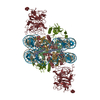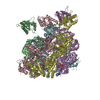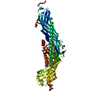+ データを開く
データを開く
- 基本情報
基本情報
| 登録情報 | データベース: EMDB / ID: EMD-5347 | |||||||||
|---|---|---|---|---|---|---|---|---|---|---|
| タイトル | 3D map of CETP-HDL complex at 14 Angstrom by optimized negative-staining EM and single-particle reconstruction | |||||||||
 マップデータ マップデータ | This is 3D reconstruction of HDL-CETP by negative-staining EM | |||||||||
 試料 試料 |
| |||||||||
 キーワード キーワード | Cholesteryl ester transfer protein / lipoprotein / CETP / LDL / VLDL / HDL / electron microscopy / CETP mechanism | |||||||||
| 生物種 |  Homo sapiens (ヒト) Homo sapiens (ヒト) | |||||||||
| 手法 | 単粒子再構成法 / ネガティブ染色法 / 解像度: 14.0 Å | |||||||||
 データ登録者 データ登録者 | Zhang L / Yan F / Zhang S / Lei D / Charles MA / Cavigiolio G / Oda M / Krauss RM / Weisgraber KH / Rye KA ...Zhang L / Yan F / Zhang S / Lei D / Charles MA / Cavigiolio G / Oda M / Krauss RM / Weisgraber KH / Rye KA / Pownall HJ / Qiu X / Ren G | |||||||||
 引用 引用 |  ジャーナル: Nat Chem Biol / 年: 2012 ジャーナル: Nat Chem Biol / 年: 2012タイトル: Structural basis of transfer between lipoproteins by cholesteryl ester transfer protein. 著者: Lei Zhang / Feng Yan / Shengli Zhang / Dongsheng Lei / M Arthur Charles / Giorgio Cavigiolio / Michael Oda / Ronald M Krauss / Karl H Weisgraber / Kerry-Anne Rye / Henry J Pownall / Xiayang Qiu / Gang Ren /  要旨: Human cholesteryl ester transfer protein (CETP) mediates the net transfer of cholesteryl ester mass from atheroprotective high-density lipoproteins to atherogenic low-density lipoproteins by an ...Human cholesteryl ester transfer protein (CETP) mediates the net transfer of cholesteryl ester mass from atheroprotective high-density lipoproteins to atherogenic low-density lipoproteins by an unknown mechanism. Delineating this mechanism would be an important step toward the rational design of new CETP inhibitors for treating cardiovascular diseases. Using EM, single-particle image processing and molecular dynamics simulation, we discovered that CETP bridges a ternary complex with its N-terminal β-barrel domain penetrating into high-density lipoproteins and its C-terminal domain interacting with low-density lipoprotein or very-low-density lipoprotein. In our mechanistic model, the CETP lipoprotein-interacting regions, which are highly mobile, form pores that connect to a hydrophobic central cavity, thereby forming a tunnel for transfer of neutral lipids from donor to acceptor lipoproteins. These new insights into CETP transfer provide a molecular basis for analyzing mechanisms for CETP inhibition. | |||||||||
| 履歴 |
|
- 構造の表示
構造の表示
| ムービー |
 ムービービューア ムービービューア |
|---|---|
| 構造ビューア | EMマップ:  SurfView SurfView Molmil Molmil Jmol/JSmol Jmol/JSmol |
| 添付画像 |
- ダウンロードとリンク
ダウンロードとリンク
-EMDBアーカイブ
| マップデータ |  emd_5347.map.gz emd_5347.map.gz | 298.3 KB |  EMDBマップデータ形式 EMDBマップデータ形式 | |
|---|---|---|---|---|
| ヘッダ (付随情報) |  emd-5347-v30.xml emd-5347-v30.xml emd-5347.xml emd-5347.xml | 12.4 KB 12.4 KB | 表示 表示 |  EMDBヘッダ EMDBヘッダ |
| 画像 |  emd_5347_1.jpg emd_5347_1.jpg | 23.9 KB | ||
| アーカイブディレクトリ |  http://ftp.pdbj.org/pub/emdb/structures/EMD-5347 http://ftp.pdbj.org/pub/emdb/structures/EMD-5347 ftp://ftp.pdbj.org/pub/emdb/structures/EMD-5347 ftp://ftp.pdbj.org/pub/emdb/structures/EMD-5347 | HTTPS FTP |
-検証レポート
| 文書・要旨 |  emd_5347_validation.pdf.gz emd_5347_validation.pdf.gz | 80.2 KB | 表示 |  EMDB検証レポート EMDB検証レポート |
|---|---|---|---|---|
| 文書・詳細版 |  emd_5347_full_validation.pdf.gz emd_5347_full_validation.pdf.gz | 79.2 KB | 表示 | |
| XML形式データ |  emd_5347_validation.xml.gz emd_5347_validation.xml.gz | 493 B | 表示 | |
| アーカイブディレクトリ |  https://ftp.pdbj.org/pub/emdb/validation_reports/EMD-5347 https://ftp.pdbj.org/pub/emdb/validation_reports/EMD-5347 ftp://ftp.pdbj.org/pub/emdb/validation_reports/EMD-5347 ftp://ftp.pdbj.org/pub/emdb/validation_reports/EMD-5347 | HTTPS FTP |
-関連構造データ
- リンク
リンク
| EMDBのページ |  EMDB (EBI/PDBe) / EMDB (EBI/PDBe) /  EMDataResource EMDataResource |
|---|
- マップ
マップ
| ファイル |  ダウンロード / ファイル: emd_5347.map.gz / 形式: CCP4 / 大きさ: 7.8 MB / タイプ: IMAGE STORED AS FLOATING POINT NUMBER (4 BYTES) ダウンロード / ファイル: emd_5347.map.gz / 形式: CCP4 / 大きさ: 7.8 MB / タイプ: IMAGE STORED AS FLOATING POINT NUMBER (4 BYTES) | ||||||||||||||||||||||||||||||||||||||||||||||||||||||||||||||||||||
|---|---|---|---|---|---|---|---|---|---|---|---|---|---|---|---|---|---|---|---|---|---|---|---|---|---|---|---|---|---|---|---|---|---|---|---|---|---|---|---|---|---|---|---|---|---|---|---|---|---|---|---|---|---|---|---|---|---|---|---|---|---|---|---|---|---|---|---|---|---|
| 注釈 | This is 3D reconstruction of HDL-CETP by negative-staining EM | ||||||||||||||||||||||||||||||||||||||||||||||||||||||||||||||||||||
| 投影像・断面図 | 画像のコントロール
画像は Spider により作成 | ||||||||||||||||||||||||||||||||||||||||||||||||||||||||||||||||||||
| ボクセルのサイズ | X=Y=Z: 2.812 Å | ||||||||||||||||||||||||||||||||||||||||||||||||||||||||||||||||||||
| 密度 |
| ||||||||||||||||||||||||||||||||||||||||||||||||||||||||||||||||||||
| 対称性 | 空間群: 1 | ||||||||||||||||||||||||||||||||||||||||||||||||||||||||||||||||||||
| 詳細 | EMDB XML:
CCP4マップ ヘッダ情報:
| ||||||||||||||||||||||||||||||||||||||||||||||||||||||||||||||||||||
-添付データ
- 試料の構成要素
試料の構成要素
-全体 : Recombinant human CETP (about 53 kDa before post-translational mo...
| 全体 | 名称: Recombinant human CETP (about 53 kDa before post-translational modifications) was expressed in the dihydrofolate reductase-deficient Chinese hamster ovary cell line DG44. The spherical HDL ...名称: Recombinant human CETP (about 53 kDa before post-translational modifications) was expressed in the dihydrofolate reductase-deficient Chinese hamster ovary cell line DG44. The spherical HDL were converted from discoidal reconstituted HDL (rHDL)by incubation with fatty acid-free bovine serum albumin, beta-mercaptoethanol, ultracentrifugally isolated LDL and purified lecithin-cholesterol acyltransferase (LCAT), and then isolated by sequential ultracentrifugation in the density range of 1.07-1.21 g/ml. |
|---|---|
| 要素 |
|
-超分子 #1000: Recombinant human CETP (about 53 kDa before post-translational mo...
| 超分子 | 名称: Recombinant human CETP (about 53 kDa before post-translational modifications) was expressed in the dihydrofolate reductase-deficient Chinese hamster ovary cell line DG44. The spherical HDL ...名称: Recombinant human CETP (about 53 kDa before post-translational modifications) was expressed in the dihydrofolate reductase-deficient Chinese hamster ovary cell line DG44. The spherical HDL were converted from discoidal reconstituted HDL (rHDL)by incubation with fatty acid-free bovine serum albumin, beta-mercaptoethanol, ultracentrifugally isolated LDL and purified lecithin-cholesterol acyltransferase (LCAT), and then isolated by sequential ultracentrifugation in the density range of 1.07-1.21 g/ml. タイプ: sample / ID: 1000 詳細: The CETP sample was thawed from storage at -70 degrees Celcius before being used, the HDL sample was freshly prepared. 集合状態: one CETP bound to one HDL / Number unique components: 2 |
|---|---|
| 分子量 | 実験値: 74 KDa / 理論値: 53 KDa / 手法: Sedimentation |
-分子 #1: Cholesteryl ester transfer protein
| 分子 | 名称: Cholesteryl ester transfer protein / タイプ: protein_or_peptide / ID: 1 / Name.synonym: CETP 詳細: optimized negative stain method was used for the CETP.HDL complex reconstruction コピー数: 1 / 集合状態: monomer / 組換発現: Yes |
|---|---|
| 由来(天然) | 生物種:  Homo sapiens (ヒト) / 別称: human / 組織: plasma Homo sapiens (ヒト) / 別称: human / 組織: plasma |
| 分子量 | 実験値: 74 KDa / 理論値: 53 KDa |
| 組換発現 | 生物種:  |
-実験情報
-構造解析
| 手法 | ネガティブ染色法 |
|---|---|
 解析 解析 | 単粒子再構成法 |
| 試料の集合状態 | particle |
- 試料調製
試料調製
| 濃度 | 0.005 mg/mL |
|---|---|
| 緩衝液 | pH: 7.4 / 詳細: DPBS buffer |
| 染色 | タイプ: NEGATIVE 詳細: CETP.HDL complex specimens were prepared for EM by the optimized NS protocol (reported in Zhang, L., J. Lipid Research, 2010, 51,5, 1228-36, and 2011, 52,1, 175-84.) |
| グリッド | 詳細: thin-carbon-coated 300 mesh copper grid (Cu-300CN, Pacific Grid-Tech, USA) |
| 凍結 | 凍結剤: NONE / 装置: OTHER |
- 電子顕微鏡法
電子顕微鏡法
| 顕微鏡 | FEI TECNAI 20 |
|---|---|
| 温度 | 最低: 94 K / 最高: 99 K / 平均: 96 K |
| 詳細 | Lose dose mode |
| 撮影 | カテゴリ: CCD フィルム・検出器のモデル: GATAN ULTRASCAN 4000 (4k x 4k) 平均電子線量: 50 e/Å2 |
| 電子線 | 加速電圧: 200 kV / 電子線源: LAB6 |
| 電子光学系 | 照射モード: OTHER / 撮影モード: BRIGHT FIELD / Cs: 2.0 mm / 最大 デフォーカス(公称値): 0.7 µm / 最小 デフォーカス(公称値): 0.1 µm / 倍率(公称値): 80000 |
| 試料ステージ | 試料ホルダー: Gatan 626 / 試料ホルダーモデル: GATAN LIQUID NITROGEN |
- 画像解析
画像解析
| 詳細 | The particles were initially selected using an automatic selection program, boxer, then manually adjusted by deleted the obviously poor quality particles. |
|---|---|
| CTF補正 | 詳細: ctffind3 in the FREALIGN software package, and corrected by EMAN |
| 最終 再構成 | アルゴリズム: OTHER / 解像度のタイプ: BY AUTHOR / 解像度: 14.0 Å / 解像度の算出法: FSC 0.5 CUT-OFF / ソフトウェア - 名称: EMAN / 使用した粒子像数: 8879 |
| 最終 2次元分類 | クラス数: 317 |
-原子モデル構築 1
| 初期モデル | PDB ID: |
|---|---|
| ソフトウェア | 名称:  Chimera Chimera |
| 詳細 | Protocol: Chimera Rigid Body Docking |
| 精密化 | 空間: REAL / プロトコル: RIGID BODY FIT / 当てはまり具合の基準: cross-correlation |
 ムービー
ムービー コントローラー
コントローラー










 Z (Sec.)
Z (Sec.) Y (Row.)
Y (Row.) X (Col.)
X (Col.)






















